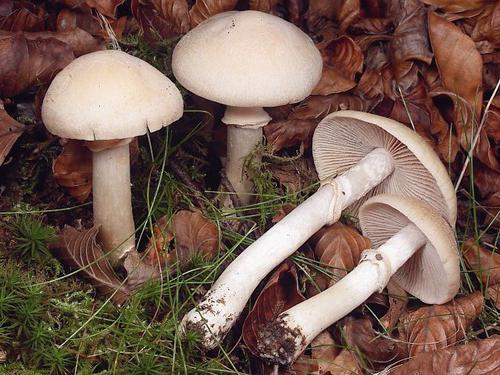The annular cap is a spiderweb fungus . He got this name for the presence on the leg of a fairly wide yellowish-white film ring. The people call it differently: chicken, dull rosette, Turk, white bog.
DescriptionThe young annular cap has a silver or powdery-white hat. Its edges are down and slightly wrapped. Over time, it turns yellow, becomes flat-convex. The edges straighten, sometimes crack (with prolonged absence of rain). The hat covers the leg like a cap. Its surface is slightly wrinkled, covered with a fibrous coating with a pearl shimmer. In diameter, it reaches 15 cm. The annular cap has a white watery pulp, which has almost no mushroom smell. The young mushroom has uneven, rare and white plates, but with time they become rusty brown. This is a characteristic feature of the old instance.

The ring-shaped mushroom has a strong leg of cylindrical shape. It is thickened at the base, dense and continuous. The surface of the legs is fibrous-silky. Its diameter is not more than 3 cm, and its length is 4-12 cm. Above the ring, the leg is covered with scales, flakes and has a yellow color. Under the ring, it is a light ocher hue. Closer to the bottom, the remains of a common purple bedspread are preserved. The spore powder has a buffy, rusty brown hue.
Habitat and distribution
Most often, the annular cap forms mycorrhiza with conifers. From deciduous he prefers beeches, oaks and birch. In the middle zone of the Russian Federation, the fungus is found in coniferous forests, where a lot of moss grows. Mixed and pine forests are preferable for him. In the northern regions, the cap can be found under dwarf birches. This mushroom prefers acidic and moist soils. He feels great in the mountains at an altitude of 2 km. White marshmallows tend to grow in compact small groups. The mushroom is also common in Belarus and some European countries. It is growing in Russia. Most often found in the western and central regions of the European part. Residents of these places can "hunt" for a ringed cap. Photos of this mushroom can be viewed in this article. Collect it from July to early October.
Culinary use and taste
The annular cap is an edible and very tasty mushroom that can be prepared in various ways. It is pickled, fried, salted, boiled. In taste, it is in no way inferior to champignons. In many Western European countries, these mushrooms are considered a great delicacy. Naturally, the most delicious are the young ringed caps. However, if an old instance is caught, then the hardened places and the leg can be cut off. This mushroom is most delicious in stewed and fried form. He is ranked in the fourth category of edibility.
Doubles
The cap is ringed inexperienced mushroom pickers can confuse with fly agaric and pale grebe. The fungus differs from them by the presence of powdery plaque on the hat, the absence of scales, as well as brown or brown-rusty plates in old specimens. In fly agarics and pale toadstools, they always retain white color.